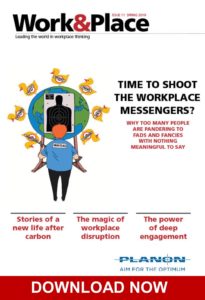Shared workspaces like The Wing are adding on-site child care for remote workers and moms returning to work after maternity leave
Parents are working more flexible hours, so they need more flexible child care.
Some freelancers and remote employees don’t need to spend thousands of dollars a year for full-time day care, because they’re able to watch their kids themselves here and there throughout the work week. So coworking spaces are starting to offer on-site child care that better fits many parents’ changing work schedules — and serves as the perfect transition for working mothers returning from maternity leave.
“I would not be able to work if it were not for a space like this,” Elizabeth Martins, a public relations manager with an 11-month-old son, told Moneyish. She joined MOMentum Coworking with Kids in the Philadelphia suburbs several months ago, as working remotely with her baby was getting “chaotic,” she said — like the time she had to hop on a surprise conference call just as her tot got fussy. “We got through it,” she said, by bouncing him on her lap the entire time. MOMentum provides coworking with childcare for mothers and fathers on Tuesdays and Thursdays from 9 a.m. to 5 p.m., which includes experienced caregivers (who have undergone background check and are certified in CPR) engaging in play time and storytime with the kids while their parents work upstairs.
So Martin pays $425 a month to use the coworking space and child care twice a week — just half as much as the $844 a month parents pay on average to keep an infant in a daycare center, according to a recent Care.com survey. And Martins found that she can focus on her work with peace of mind because she knows that her son is being cared for on the next floor.
“I was exclusively breastfeeding, so I could pump (the workspace includes private rooms) and then bring his meal to him, and then also being able to see him when I brought down his milk was really nice,” said Martins, 33. “I’m able to continue with my career fluidly. I don’t feel that my boss notices any changes in the way I work. I’m able to comfortably be a mom and a worker at the same time. It’s the answer to the age-old work-life balance problem.”

The Wing is adding on-site child care to its network of coworking spaces. (The Wing)
On Wednesday, women’s club and coworking space network The Wing announced that it’s rolling out childcare for its 6,000 members across its five current locations, beginning with its Soho (NYC) and West Hollywood sites in December. (When new spaces in Chicago, Toronto and London next year, they will also include child care.) The on-site Little Wing service will be staffed by certified babysitters for an extra cost (still to be determined) while their moms, who pay $215 monthly and $2,350 annually, can work, network or just unwind on site.
“Being a parent is a full-time job, and it’s one of the hardest jobs,” Lauren Kassan, The Wing co-founder and mother of a 9-month-old, told Moneyish. “About 20% of our members have children, and (child care) was one of the top requested things from our network. Hopefully we can make our members’ lives easier, as well as provide a community for them.”
A growing 3.9 million Americans now work from home at least half of the week, according to FlexJobs’ most recent State of the Remote Job Marketplace report. Hiring managers predict that more than one third of their employees will WFH within the next decade. So coworking spaces like WeWork have emerged to provide a shared place where one can hustle for less than what it costs to rent a traditional office, and in a more professional setting with more resources than your couch. There are more than 4,000 coworking facilities across the U.S., according to Emergent Research, and around 25 to 30 are now offering on-site child care.
“The workplace is changing and becoming more flexible, but we haven’t really seen child care go along with that – it’s either all (full-time) or nothing,” Marlene Mejia Weiss, co-executive director of The Inc coworking and child care center in Seattle, told Moneyish. “Full-time child care is an option that can work really well for a two-parent household (with both parents working full-time), but there is this a group of parents that just needs care for a few hours or a few days — not that daily 7 a.m. to 6 p.m. option; they’re looking for four hours here or there as it works with their projects.”
ALSO READ: We need to talk about childcare expenses if we’re going to plan for them
Places offering that flexibility include Nido in Durham, N.C., which opened in 2013 and runs $200 a month for one half-day a week. Work and Play in South Orange, N.J. lets members pick how many days a week and how many hours a day that their child comes in, for two and six hours a day. Rates run from $75 for 15 hours to be used as-needed over three months, to $275 a month for an all-access pass, plus $15 to $16.50 extra for child care. They’re being joined by Thirdspace Coworking & Childcare opening in Nebraska early next year.
The coworking child care market is advancing slowly because it’s a challenging business model to get off the ground. For instance, Workafrolic in Washington, D.C., which offered coworking and childcare plans starting at $499 a month, recently closed and is looking for new investors. “I know that this type of business is needed and viable, however it requires more resources than I alone have access to,” the owner wrote in a statement. And child care licensing standards vary by state, so many coworking spaces avoid the red tape by only watching kids for only a few hours a day, or requiring that the parent remains in the building.

The Wing is adding on-site child care to its network of coworking spaces. (The Wing)
“There’s not a big profit margin,” Mary Beth Thomas, a cofounder of MOMentum, told Moneyish. “But we think that maybe we’ve found the secret formula.” Rather than building or renting their own space, they work out of a couple of churches — which already had many of the rooms, toys and furniture needed — to save money. The Inc did the same. “So we don’t have a fancy space with posh furniture, but we partner with local community organizations and do a lot of networking events and seminars, and we partner with gurus in wellness and women’s health,” added Thomas, “and we’ve built a parenting support network that we’re really proud of.”
So this is still a very niche service — but one that has the potential to disrupt the child care industry once it grows up. The cost of sending a 4-year-old to a full-time preschool in 41 states exceeds 10% of a median family income — the level that the federal government considers affordable, according to The Wall Street Journal (which shares a parent company with Moneyish.) Full-time preschool is more expensive than the average tuition at a public college in 23 states. And a Brookings Institution report found that parents pay a medium $8,320 a year for a kid under five to attend day care at least eight hours a week.
ALSO READ: the cost of childcare just hit an all-time high
Martins said that the full-time day care centers and nannies that she originally researched around Philadelphia cost “two or three times as much” as what she is paying at MOMentum now. “I’m not knocking daycare at all,” she added. “But because I’m remote, it just didn’t make sense to go somewhere that was five days a week. Plus, I live in a very family-friendly area, and it’s tough to get into a daycare. The waitlists are one to two years long.”
This flexible child care option can also help many women avoid the “motherhood penalty,” where women with children earn less than those without kids. Mothers are perceived as less committed to their jobs and are held to higher punctuality standards, as they are most likely to be the caregivers for children and sick family members. So having help with child care can help avoid those issues.

The Wing is adding on-site child care to its network of coworking spaces. (The Wing)
And LeanIn.org reports that 43% of highly qualified women with children are leaving their careers or off-ramping for a period of time because the traditional workplace doesn’t accommodate mothers. Many can’t find a place to pump, if they are trying to breastfeed their kids. Being able to work, pump and keep an eye on their little ones in the same place at an affordable price has the potential to keep more moms employed and advancing in their careers.
Weiss said that she didn’t return to work in sports marketing once her maternity leave was up several years ago because, “I was not ready to give my child to someone else at three or four months,” she said. “But I would have stayed at my job if The Inc existed then, because I would have felt more comfortable if I could work part-time and still be close to my kiddo.”
© 2018 Dow Jones & Company, Inc. All Rights Reserved
Author:
Originally Published on October 25, 2018 at 11:43PM
Article published originally via coworking – Google News https://moneyish.com/upgrade/how-some-coworking-spaces-are-disrupting-the-child-care-industry/




